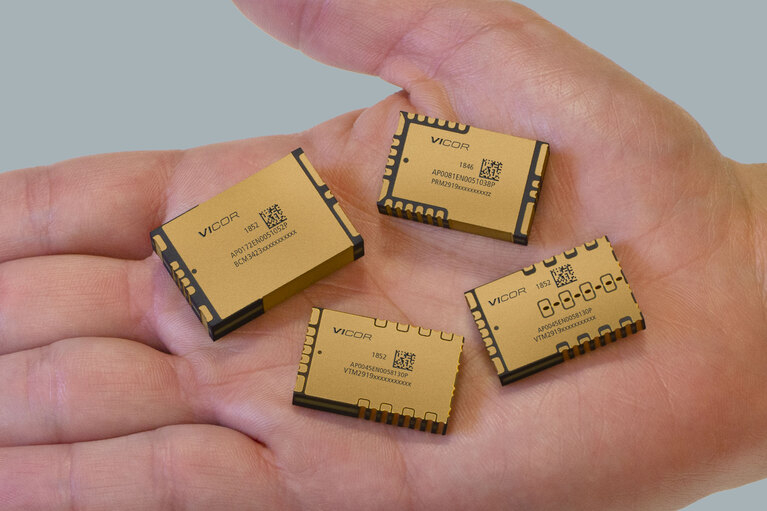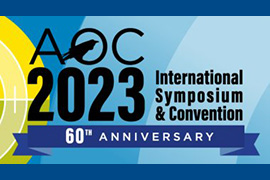
Power delivery networks for New Space
Space is an unforgiving environment demanding flawless reliability. Vicor radiation-tolerant power modules are proven to withstand the rigors of New Space
A satellite constellation with advanced communications technology has comparable latency to fiber and is capable of transporting multiple gigabits of network traffic to virtually any location. Bandwidth-intensive applications and the number of smart connected devices are rapidly increasing, requiring high-performance connectivity for businesses, ships, airplanes, autonomous vehicles and broadband internet users, anytime and anywhere around the world.
New LEO and MEO satellites are equipped with breakthrough digital payload electronics and require high-density, high-efficiency, low-noise power delivery networks (PDNs), particularly for their advanced networking ASICs. These power delivery solutions must also be tolerant to both TID (total ionizing dose) radiation and SEE (single event effects).
Vicor radiation-tolerant power modules enable the ideal Power Delivery Network (PDN) for today’s LEO and MEO satellites, providing high efficiency, high density, low-noise voltage conversion to power advanced network communication ASICs and processors.
Power delivery performance and reliability are ensured by using proven topologies and Vicor standard CM-ChiPTM module construction on fully automated high volume lines in Andover, Massachusetts. Both TID and SEE radiation tolerance are ensured by careful component selection, qualification testing, and lot testing. Additionally, a dual power train fault-tolerant topology eliminates single event functional interrupts (SEFI).
Providing complete source to point-of-load radiation-tolerant COTS solutions allow developers to reduce time to market and cost while maximizing board space utilization. Vicor power modules enable innovation in aerospace, defense, and supercomputing applications powering advanced communication arrays and the most advanced processors used for AI today.
For over 40 years Vicor has designed and manufactured its innovative and award-winning power modules in the United States. Vicor recently expanded its manufacturing capability with the debut of the world’s first ChiP (Converter housed in Package) fabrication facility, capable of manufacturing higher quality power modules faster and more efficiently. This new “ChiP fab” is vertically integrated enabling Vicor to have greater control of the entire manufacturing life-cycle process, thus reducing the risk of supply chain interruptions to our valued customers. To further ease the supply chain barriers for our international customers, Vicor rad-tolerant space products are all classified as EAR99 making them exempt from ITAR (International Traffic in Arms Regulations) restrictions.
Single event functional interrupt (SEFI) immunity is achieved using a redundant architecture, where two identical and parallel powertrains with fault-tolerant control ICs are housed in a single, high-density SM-ChiP package.


Factorized modular power architecture

Low noise

High efficiency

High power and current density
Factorized Power Architecture (FPA) factorizes power from the traditional single-function DC-DC converter into two distinct functions and power modules: a pre-regulation module, a PRM and a voltage transformation module, a VTM. The power switching topologies and control systems of each module are optimized for low noise and power losses, with zero-current and zero-voltage switching. The PRM and VTM components have high density, high efficiency, low noise operation and factorization allows the VTM to be placed close to the load minimizing board losses in high current applications.


BCM3423 bus converter module
Isolated fixed-ratio
Input: 100V (94 – 105V, 120V transient)
Output: 33V (31 – 35V)
Power: 400W
K factor: 1/3
Peak efficiency: 96%
33.5 x 23.1 x 7.4mm
26g
50k rad, 35MeV-cm2/mg
PRM2919 regulator module
Non-isolated regulated
Input: 33V (30 – 36V)
Output: 25V (13.4 – 35V)
Power: 200W
Current: IOUT 7.69A
Peak efficiency: 97.5%
29.2 x 19.0 x 7.4mm
18.2g
50k rad, 35 MeV-cm2/mg
VTM2919 0.8V, 150A voltage transformation module
Isolated fixed-ratio
Input: 25V (13.4 – 35V)
Output: 0.42 – 1.1V
Current: 150A
K factor: 1/32
Peak efficiency: 94.3%
29.2 x 19.0 x 4.9mm
13.3g
50k rad, 35 MeV-cm2/mg
VTM2919 3.3V, 50A voltage transformation module
Isolated fixed-ratio
Input: 16 – 32V
Output: 2 – 3.8V
Current: 50A
K factor: 1/8
Peak efficiency: 94%
29.2 x 19.0 x 5.5mm
11g
50k rad, 35MeV-cm2/mg
Power delivery networks for New Space
Space is an unforgiving environment demanding flawless reliability. Vicor radiation-tolerant power modules are proven to withstand the rigors of New Space
DC-DC converters for NewSpace applications
Smaller satellites harvest less energy using a modular approach to minimize I2R distribution losses, maximize efficiency and improve transient response
For New Space satellites, radiation tolerance means new design hurdle
Vicor power modules are power dense, reliable and scalable. Furthermore, there are multiple benefits of soft switching in radiation-tolerant power systems
60th Annual AOC International Symposium & Convention
The premier EW and Radar technology event of the year




